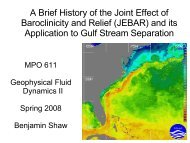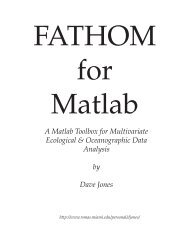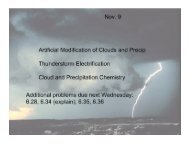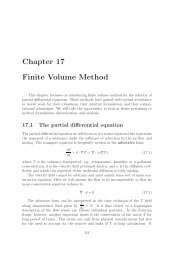2007 (PDF) - Rosenstiel School of Marine and Atmospheric Science ...
2007 (PDF) - Rosenstiel School of Marine and Atmospheric Science ...
2007 (PDF) - Rosenstiel School of Marine and Atmospheric Science ...
You also want an ePaper? Increase the reach of your titles
YUMPU automatically turns print PDFs into web optimized ePapers that Google loves.
Hurricanes & Forecasting<br />
Warm Ocean Effects<br />
Dr.. Nick Shay, pr<strong>of</strong>essor <strong>of</strong> Meteorology <strong>and</strong> Physical oceanography<br />
at the <strong>Rosenstiel</strong> <strong>School</strong>, <strong>and</strong> his Upper Ocean Processes<br />
Laboratory team are also producing high dem<strong>and</strong> scientific results<br />
to assist in the underst<strong>and</strong>ing <strong>of</strong> the complex processes involved<br />
in hurricane intensification. Based on satellite <strong>and</strong> in situ measurements<br />
on variations in the oceanic heat content (OHC) throughout<br />
the Gulf <strong>of</strong> Mexico <strong>and</strong> in the Loop Current, the data have become<br />
a valuable source <strong>of</strong> hurricane prediction <strong>and</strong> evolution information<br />
for the Statistical Hurricane Intensity Prediction Scheme<br />
(SHIPS) at the National Hurricane Center (NHC).<br />
Variations in the OHC played an important role in hurricane intensification<br />
as seen in Hurricanes Katrina, Rita <strong>and</strong> Wilma which<br />
all reached Category 5 strengths in 2005, <strong>and</strong> more recently during<br />
Hurricane Dean’s passage in <strong>2007</strong>. Using these OHC variations<br />
have improved intensity forecasting by an average <strong>of</strong> 6 percent over<br />
the basin, <strong>and</strong> in some cases by as much as 22 percent, as was the<br />
case with Hurricane Ivan.<br />
The OHC’s importance lies in its accuracy to depict the average<br />
heat storage in the upper ocean from the sea surface to a depth<br />
where the water temperature is 78°F (26°C). The deeper the warm<br />
water, the higher the value <strong>of</strong> the OHC <strong>and</strong> vice versa. When these<br />
values are high, there is more transfer <strong>of</strong> heat to the hurricane as<br />
these deep warm regimes (such as the Loop Current <strong>and</strong> Warm eddies)<br />
tend to resist wind stirring <strong>and</strong> mixing that work to decrease<br />
the upper ocean’s temperatures. Similarly, Shay’s approach also<br />
maps cold features that tend to diminish the available heat transfer<br />
to the atmosphere.<br />
In collaboration with NOAA’s Hurricane Forecasting Intensity<br />
Program, <strong>and</strong> supported by the Minerals Management Service <strong>and</strong><br />
the National <strong>Science</strong> Foundation, the team is gearing up to acquire<br />
ocean temperature <strong>and</strong> current pr<strong>of</strong>ile measurements from aircraft<br />
in the Loop Current, during hurricane passage over the next three<br />
years. A grant from NOAA’s Joint Hurricane Testbed is allowing<br />
this project to exp<strong>and</strong> its reach into the Eastern Pacific Ocean<br />
Ocean heat content (kJ cm-2) variations in the Northwest Caribbean Sea <strong>and</strong><br />
Gulf <strong>of</strong> Mexico relative to Hurricanes Dean (<strong>2007</strong>) <strong>and</strong> Gilbert (1988). Notice<br />
that the core <strong>of</strong> the Loop Current in the Gulf <strong>of</strong> Mexico begins in the Northwest<br />
Caribbean Sea. Credit: NOAA/RSMAS<br />
basin, as well. This novel approach is now being incorporated into<br />
SHIPS models at several centers, including the Central Pacific Hurricane<br />
Center <strong>and</strong> the NHC.<br />
Cyclogenesis Short Cut<br />
One <strong>of</strong> the most important goals <strong>of</strong> hurricane forecasting is to<br />
provide sufficient lead time for coastal communities to prepare<br />
before a storm’s l<strong>and</strong>fall. While the exact location <strong>and</strong> intensity <strong>of</strong> a<br />
l<strong>and</strong>falling hurricane can not be predicted, in most cases there are<br />
at least 48 hours <strong>of</strong> advance knowledge that a significant event is<br />
likely to occur. Such was the case for some <strong>of</strong> the most significant<br />
hurricanes in recent history, such as Hurricane Andrew <strong>and</strong> Hurricane<br />
Katrina.<br />
Using a modified version <strong>of</strong> the Weather Research <strong>and</strong> Forecasting<br />
(WRF) model, Dr. David Nolan, assistant pr<strong>of</strong>essor <strong>of</strong> Meteorology<br />
<strong>and</strong> Physical Oceanography at the <strong>Rosenstiel</strong> <strong>School</strong>, has been<br />
studying hurricane formation <strong>and</strong> strengthening in “ideal” environments<br />
- those with warm ocean temperatures, high humidity, <strong>and</strong><br />
little or no wind shear.<br />
Most hurricanes form over a period <strong>of</strong> five to seven days when a<br />
larger, weak circulation slowly contracts to a more intense vortex.<br />
In a paper published in <strong>2007</strong> in Australian Meteorological Magazine,<br />
Nolan has shown that in very ideal circumstances, the path<br />
to hurricane development can take a “short-cut,” in which a new,<br />
smaller, <strong>and</strong> faster developing circulation can form inside <strong>of</strong> the<br />
larger disturbance. While these results initially seemed overly<br />
hypothetical, Hurricane Humberto went from a tropical depression<br />
to a l<strong>and</strong>falling Category 1 hurricane in less than 24 hours in<br />
<strong>2007</strong>, demonstrating that this same process can, <strong>and</strong> does, occur in<br />
nature. Tropical Cyclone Larry in Northeast Australia, which went<br />
from a depression to a powerful l<strong>and</strong>falling Category 4 hurricane<br />
in just two <strong>and</strong> a half days, served as another vivid example <strong>of</strong> this<br />
atmospheric process in action in 2006.<br />
Computer simulations are now being used by Nolan <strong>and</strong> his colleagues<br />
to identify what variables <strong>and</strong> locations, particularly in the<br />
middle-levels <strong>of</strong> the atmosphere, should be observed in order to<br />
anticipate <strong>and</strong> forecast rapid cyclogenesis <strong>and</strong> intensification.<br />
The models show what radar images <strong>of</strong> a simulated, rapidly intensifying storm would<br />
look like at three <strong>and</strong> four days after the start <strong>of</strong> the simulation. After 72 hours, the<br />
storm has no discernible eye <strong>and</strong> there is only disorganized b<strong>and</strong>ing; just 24 hours<br />
later a distinct eye <strong>and</strong> prominent spiral b<strong>and</strong>s are clearly visible. Credit: David<br />
Nolan<br />
Threat Forecasting<br />
In the aftermath <strong>of</strong> Hurricane Katrina the U.S. Army Corps <strong>of</strong><br />
Engineers created Task Force Guardian to begin restoring elements<br />
<strong>of</strong> New Orleans’ battered hurricane-flood system. The Task<br />
Force implemented a plan to close the interim gated structures at<br />
the three outfall canals (17th Street, Orleans Avenue <strong>and</strong> London<br />
Avenue Canals) to prevent storm surge water in Lake Pontchartrain<br />
from entering these outfall canals <strong>and</strong> flooding the area.<br />
In the event that a tropical storm system threatens the Gulf Coast<br />
region, <strong>and</strong> metropolitan New Orleans in particular, the University<br />
<strong>of</strong> Miami, as part <strong>of</strong> the National Oceanographic Partnership<br />
Program (NOPP), has created a project called “Real-Time Forecasting<br />
System <strong>of</strong> Winds, Waves <strong>and</strong> Surge in Tropical Cyclones,”<br />
led by Dr. Hans C. Graber, Applied <strong>Marine</strong> Physics chairman <strong>and</strong><br />
pr<strong>of</strong>essor. The project team provides two critical pieces <strong>of</strong> information<br />
required to determine the need for gate closures: predicted<br />
stages in Lake Pontchartrain, <strong>and</strong> predicted wind speeds at the<br />
mouths <strong>of</strong> the three outfall canals. If a hurricane threatens the Gulf<br />
Coast <strong>and</strong> the storm surge forecast exceeds pre-established safe<br />
water levels, the gates would be closed to prevent flooding <strong>of</strong> local<br />
parishes. The forecast <strong>of</strong><br />
water stages alone is not<br />
sufficient, because the<br />
gates have to be opened<br />
<strong>and</strong> closed by cranes that<br />
cannot be operated in high<br />
wind conditions –making<br />
accurately predicted wind<br />
time histories <strong>of</strong> grave<br />
importance.<br />
Operational in both the<br />
2006 <strong>and</strong> <strong>2007</strong> hurricane<br />
seasons, the threat forecast<br />
Pump station in New Orleans, the site <strong>of</strong> the<br />
levee failure at the 17th Street Canal. Photo<br />
credit: Chris Sinigalliano<br />
for New Orleans provides an important tool for emergency management<br />
personnel. Predictions from the NOPP are based on the<br />
most <strong>of</strong>ficial track forecasts from the National Hurricane Center,<br />
as well as alternate tracks from other weather forecast models used<br />
to compute probabilities associated with predicted stages <strong>and</strong> wind<br />
speeds. The results are made available through e-mail text <strong>and</strong><br />
graphics messages, a dedicated website <strong>and</strong> in a condensed form for<br />
Personal Digital Assistants (PDA’s).<br />
Wind-Wave Winner<br />
Beyond the Tropics<br />
Ivan Savelyev. Photo credit: UM/RSMAS<br />
Applied <strong>Marine</strong> Physics student Ivan Savelyev was recognized as an Outst<strong>and</strong>ing Student Paper<br />
award winner for his presentation at the American Geophysical Union (AGU) meeting held annually<br />
in San Francisco, Calif. His paper entitled, “Laboratory Study <strong>of</strong> Surface Gravity Wave Energy<br />
Input,” was one <strong>of</strong> only eight recognized, from a field <strong>of</strong> 215 paper presentations.<br />
Savelyev, a student <strong>of</strong> Drs. Mark Donelan <strong>and</strong> Brian Haus, used the school’s unique Air-Sea Interaction<br />
Saltwater Tank (ASIST) for his work. In particular, Savelyev was exploring a new technique to<br />
measure the rate <strong>of</strong> momentum that transfers from wind to waves. Using the tank he was able to<br />
simulate different wind <strong>and</strong> wave conditions in the one-<strong>of</strong>-a-kind laboratory to measure air pressure<br />
fluctuations caused by wind along the surface <strong>of</strong> a wave. Based on those <strong>and</strong> other measurements,<br />
he <strong>and</strong> his pr<strong>of</strong>essors are now able to calculate the momentum transfer from wind to waves<br />
for different wind speeds <strong>and</strong> wave fields, including hurricane force conditions. Ultimately, this<br />
science will be incorporated into predictive weather models to help further improve their accuracy.<br />
In addition to forecasting tropical cyclones, faculty members at the <strong>Rosenstiel</strong> <strong>School</strong> are also<br />
working diligently to improve forecasts <strong>of</strong> severe winter weather. Using a mathematical<br />
method based on 'ensembles' <strong>of</strong> weather forecasts, Meteorology <strong>and</strong> Physical Oceanography<br />
Pr<strong>of</strong>essor Dr. Sharan Majumdar <strong>and</strong> graduate student Kathryn Sellwood have been exploring<br />
whether one can accurately identify 'target' areas over the Pacific Ocean in which satellite<br />
<strong>and</strong> aircraft measurements can help make better forecasts <strong>of</strong> heavy rain <strong>and</strong> winter storms ---<br />
up to one week in advance <strong>of</strong> the actual event.<br />
Their research has found that the 'targets' are <strong>of</strong>ten reliable, helping to improve the predictive<br />
accuracy <strong>and</strong> extend the time range <strong>of</strong> winter forecasts. Based on this research, NOAA Dr. Sharan Majumdar <strong>and</strong> <strong>2007</strong> Dean’s<br />
will be deploying their G-IV jet aircraft out <strong>of</strong> Japan from January to March 2009, to help Prize winner Kathryn Sellwood review their<br />
improve forecasts <strong>of</strong> blizzards <strong>and</strong> other weather phenomena over the continental United prediction <strong>of</strong> atmospheric ‘target’ areas. Photo<br />
States <strong>and</strong> Alaska.<br />
credit: Christian Howard<br />
3 4





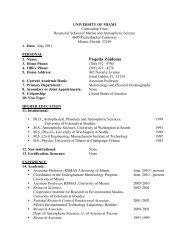
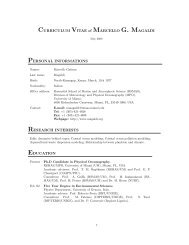
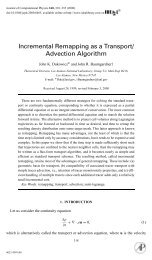
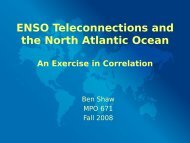
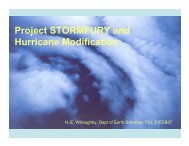
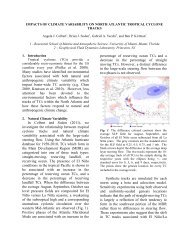
![Wavelength [μm] ZENITH ATMOSPHERIC TRANSMITTANCE](https://img.yumpu.com/26864082/1/190x143/wavelength-i-1-4-m-zenith-atmospheric-transmittance.jpg?quality=85)

